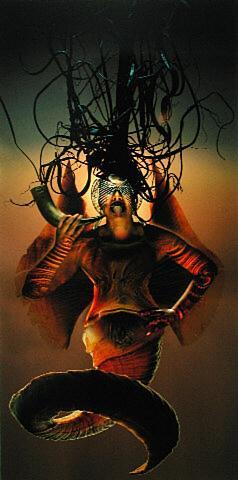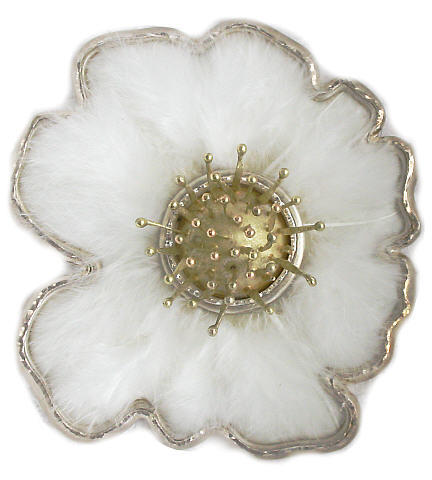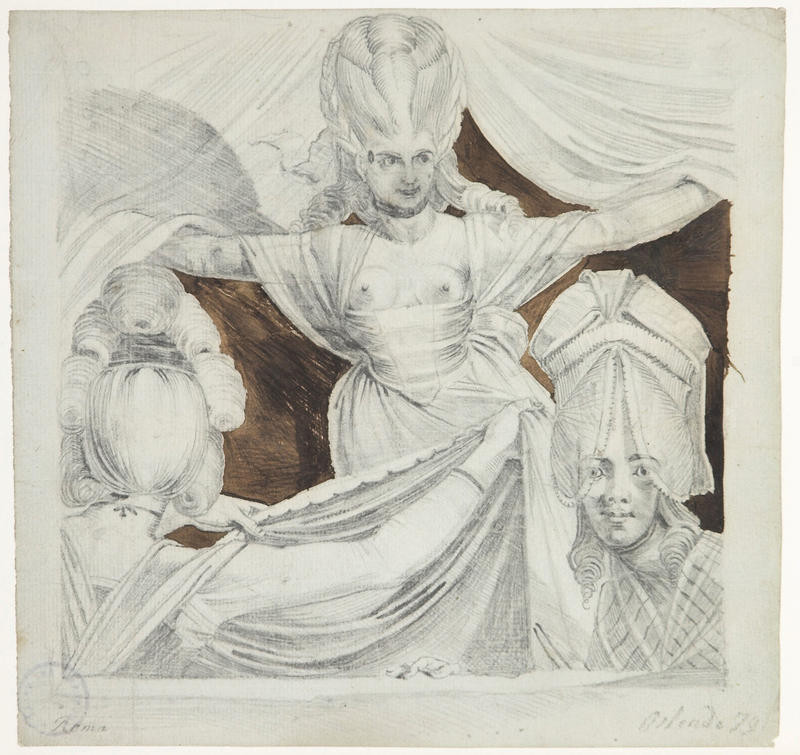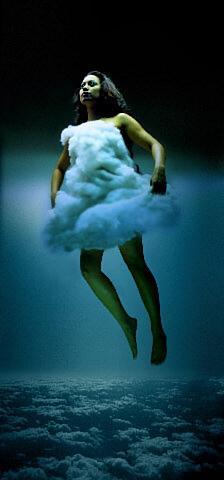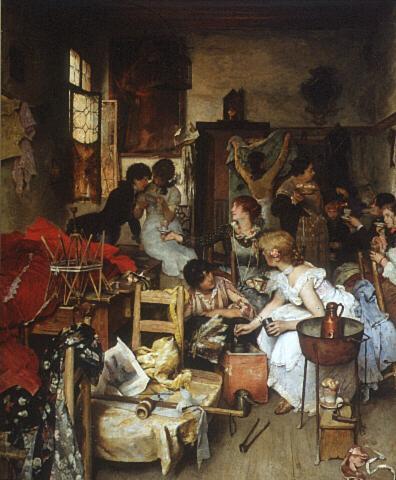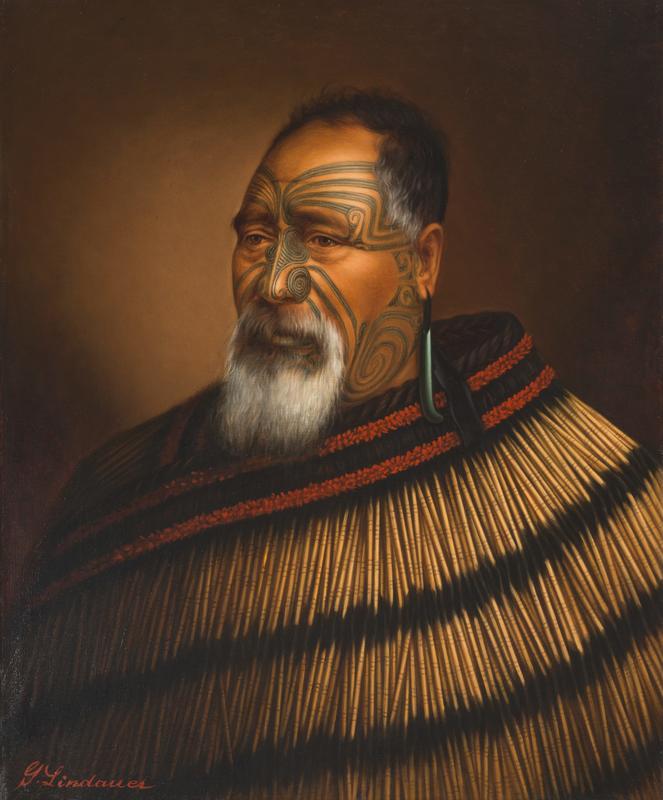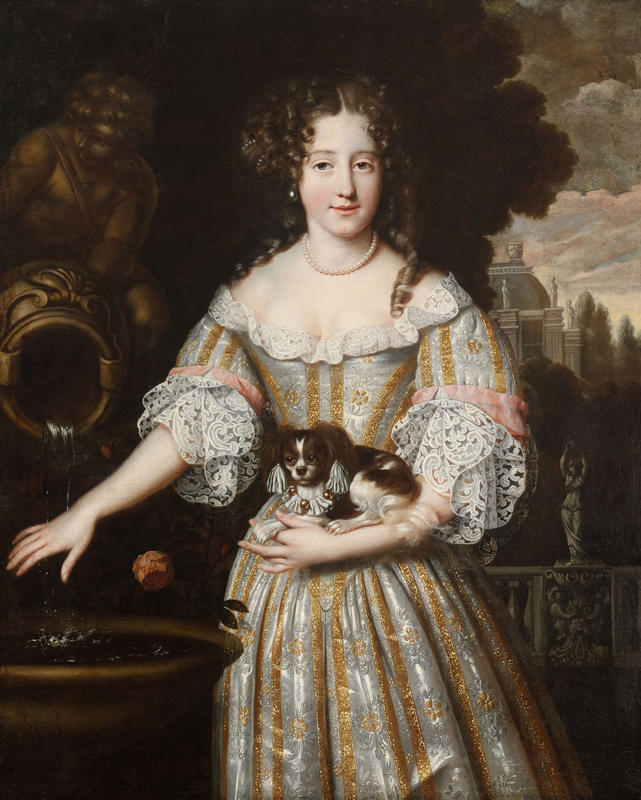—
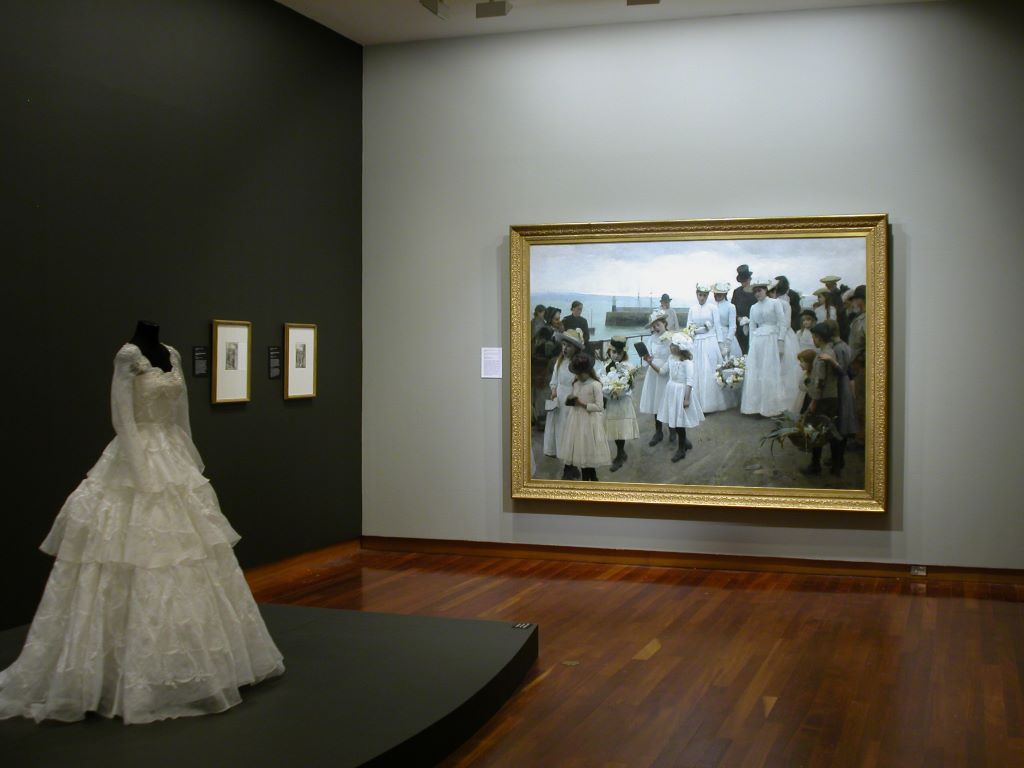
exhibition Details
Flaunt: to display (possessions, oneself, etc) ostentatiously; to show off; to wave or cause to wave freely; to flutter...
Societies, and the positions individuals hold within them, are visibly demarcated through dress, whether by elements of adornment, or by clothes that depict the wearer's status and function. A king without his robes and crown is a man by any other name; a woman in a tailored trouser suit refuses to be proscribed by traditional notions of femininity.
Flaunt draws on the wide range of works in Auckland Art Gallery Toi o Tamaki's collections that deal with issues related to the history of dress and identity. These works come from many different periods in art, and rather than being shown chronologically, will be displayed according to particular themes, allowing comparisons and contrasts to be made across time and place.
The exhibition explores a range of themes, and includes costumes on loan from public and private New Zealand collections and works created within the fashion industry, to illustrate fashion throughout the ages.
Crosspolynation looks at the way in which artists and designers from different periods and cultures have always borrowed from one another, a practice that continue to inform design even today.
Styling Modernity illustrates that with the rise of Modernism in the 20th century, fashion for women took on a new freedom. Women artists not only recorded the fashion of the day in their paintings but also took an active role in their production, with many of their designs being created for textile printing.
Courting Attention - This section of the exhibition shows the richness of courtly attire, clearly illustrated by the rich brocades, lace and powdered wigs of both men and women prior to more austere male costuming in the 19th century. Allan Ramsay's two 18th century portraits of King George III and his wife Queen Charlotte demonstrate their position and their power through the lavish fabrics and accessories with which they are draped.
Masking Desire - Fashion is a marker of desire, the draped body frequently appearing more erotic than when naked. Masking Desire looks at the subtle messages that lie within ostensibly formal portraits, and considers the way different parts of the body become the focus of attention in different periods.
Rites of Passage explores the way in which ceremonies that mark birth, death and marriage are signified through costume.
In Inside Out costume moves from the highly figurative to the deconstructed work of Julia Fong and Pip Culbert, whose shirt consists only of seams. More traditional photography includes Brian Brake's photograph of Picasso autographing a woman's dress, thereby turning the garment into a work of art.
- Date
- —
- Curated by
- Mary Kisler, Jane Davidson and Laura Jocic
- Location
- Main Gallery, Upper Level
- Cost
- Adult: $7, Concession: $5, Children Under 12: Free, Friends of the Gallery: $4, Free entry on Mondays
Related Artworks
Self-portrait with side of pe'a, Basque Road, Newton Gully
gelatin silver print, toned with gold and selenium
Auckland Art Gallery Toi o Tāmaki, purchased 1996
Kopukapuka
sterling silver, 9ct gold, white feathers
Auckland Art Gallery Toi o Tāmaki, purchased 2003
Portrait of a Lady
On display
The Morning Walk, Squire Hallett and his Wife
colour mezzotint
Auckland Art Gallery Toi o Tāmaki, purchased 1926
Elizabeth de Valois, Reine d'Espagne
etching
Auckland Art Gallery Toi o Tāmaki, gift of the relatives of Mr T V Gulliver, 1939
Wikitoria's Room
builder's paper, plastic and MDF board
Auckland Art Gallery, Toi o Tāmaki, purchased 2001
The Tavern Scene
engraving
Auckland Art Gallery Toi o Tāmaki, gift of Professor and Mrs A G Bogle, 2002
The Wind in a frolic
gelatin silver photographic print
Auckland Art Gallery Toi o Tāmaki, purchased 1990
Le guerrier au chapeau orne d'une grande plume
etching
Mackelvie Trust Collection, Auckland Art Gallery Toi o Tāmaki, bequest of Dr Walter Auburn, 1982
At the cafe - Picasso autographing a woman's dress
black and white photograph
Auckland Art Gallery Toi o Tāmaki, gifted in memory of Brian Brake, by a friend of the artist, 1989
For of such is the Kingdom of Heaven
oil on canvas
Mackelvie Trust Collection, Auckland Art Gallery Toi o Tāmaki, purchased 1913
Young Negress
etching
Mackelvie Trust Collection, Auckland Art Gallery Toi o Tāmaki, bequest of Dr Walter Auburn, 1982
The Actor Sawamura Gennosuke II
woodcut - nishiki-e (full colour) technique
Mackelvie Trust Collection, Auckland Art Gallery Toi o Tāmaki
Dried Blood
canvas, nylon, wool, hessian, and acrylic fabric, steel tube
Chartwell Collection, Auckland Art Gallery Toi o Tāmaki, 1983
Portrait of Frances Hodgkins
oil on canvas
Auckland Art Gallery Toi o Tāmaki, purchased with funds from the William James Jobson Trust, 1954
On display
Mary, Princess of Orange
etching
Mackelvie Trust Collection, Auckland Art Gallery Toi o Tāmaki, bequest of Dr Walter Auburn, 1982
George Lavington, Bishop of Exeter
oil on canvas
Mackelvie Trust Collection, Auckland Art Gallery Toi o Tāmaki, purchased 1960
On display
Nuclear Rosary - White Sunday
plastic flowers, rosary beads, crucifix, sterling silver and fishing line
Auckland Art Gallery Toi o Tāmaki, purchased 2000
The Marriage of Ferdinand de' Medici and Christine of Lorraine (Le mariage de Ferdinando)
engraving
Mackelvie Trust Collection, Auckland Art Gallery Toi o Tāmaki, bequest of Dr Walter Auburn, 1982
Earl of Essex on Foot
etching
Mackelvie Trust Collection, Auckland Art Gallery Toi o Tāmaki, bequest of Dr Walter Auburn, 1982
Florentine gentlewoman with a little muff (Donna Fiorentina collo scuffino
engraving
Auckland Art Gallery Toi o Tāmaki, gift of Mr Dennis R Nathan, 1972
Lechery
etching
Mackelvie Trust Collection, Auckland Art Gallery Toi o Tāmaki, bequest of Dr Walter Auburn, 1982
Summer
etching
Mackelvie Trust Collection, Auckland Art Gallery Toi o Tāmaki, bequest of Dr Walter Auburn, 1982
Cleopatra
oil on panel
Mackelvie Trust Collection, Auckland Art Gallery Toi o Tāmaki, purchased 1916
Kalashnikov Copy
oil stick and marker pen on fabric
Chartwell Collection, Auckland Art Gallery Toi o Tāmaki, 2002
Aflatoxin Bomb
oil stick and fabric marker pen on Parisian fabric
Auckland Art Gallery Toi o Tāmaki, gift of the artist, 2002
Two Courtesans with fantastic hairstyles and hats
pen with brown, pink and grey wash, body colour
Auckland Art Gallery Toi o Tāmaki, purchased 1965
Bite out
gelatin silver photograph
Auckland Art Gallery Toi o Tāmaki, gift of the artist, 1992
<<I know what I'm doing>> <<12 gauge shotgun>> <<17.4.2003>>
oil stick and marker pen on fabric
Chartwell Collection, Auckland Art Gallery Toi o Tāmaki, 2003
<<Anthrax>> <<17.4.2003>>
oil stick and marker pen on fabric
Chartwell Collection, Auckland Art Gallery Toi o Tāmaki, 2003
<<Benzodiazepine gas>> <<17.4.2003>>
oil stick and marker pen on fabric
Chartwell Collection, Auckland Art Gallery Toi o Tāmaki, 2003
<<Co-operate, baby>> <<unmanned C.I.A. drone>> <<17.4.2003>>
oil stick and marker pen on fabric
Chartwell Collection, Auckland Art Gallery Toi o Tāmaki, 2003
<<Infra-red decoy>> <<17.4.2003>>
oil stick and marker pen on fabric
Chartwell Collection, Auckland Art Gallery Toi o Tāmaki, 2003
<<Nerve agent VX>> <<17.4.2003>>
oil stick and marker pen on fabric
Chartwell Collection, Auckland Art Gallery Toi o Tāmaki, 2003
<<Not worth dying for>> <<e-bomb>> <<17.4.2003>>
oil stick and marker pen on fabric
Chartwell Collection, Auckland Art Gallery Toi o Tāmaki, 2003
<<Surface-to-air batteries>> <<17.4.2003>>
oil stick and marker pen on fabric
Chartwell Collection, Auckland Art Gallery Toi o Tāmaki, 2003
<<Yes, I am famous>> <<nut & nail bomb>> <<17.4.2003>>
oil stick and marker pen on fabric
Chartwell Collection, Auckland Art Gallery Toi o Tāmaki, 2003
<<You are going to be "it">> <<smallpox virus>> <<17.4.2003>>
oil stick and marker pen on fabric
Chartwell Collection, Auckland Art Gallery Toi o Tāmaki, 2003
<<You don't believe I'm rich>> <<fentanyl & halothane cocktail>> <<17.4.2003>>
oil stick and marker pen on fabric
Chartwell Collection, Auckland Art Gallery Toi o Tāmaki, 2003
<<You're a waste of space>> <<ricin>> <<17.4.2003>>
oil stick and marker pen on fabric
Chartwell Collection, Auckland Art Gallery Toi o Tāmaki, 2003
Beauty directed by Prudence rejects with Scorn the Solicitations of Folly
stipple engraving
Auckland Art Gallery Toi o Tāmaki, purchased 2003
La dame a l'eventail
etching
Mackelvie Trust Collection, Auckland Art Gallery Toi o Tāmaki, bequest of Dr Walter Auburn, 1982
La dame a la grande collerette et a la coiffe retombant en arriere
etching
Mackelvie Trust Collection, Auckland Art Gallery Toi o Tāmaki, bequest of Dr Walter Auburn, 1982
La dame a la petite coiffe relevee en arriere
etching
Mackelvie Trust Collection, Auckland Art Gallery Toi o Tāmaki, bequest of Dr Walter Auburn, 1982
La dame au masque
etching
Mackelvie Trust Collection, Auckland Art Gallery Toi o Tāmaki, bequest of Dr Walter Auburn, 1982
La dame coiffée d'un grand voile et a la robe bordee de fourrures
etching
Mackelvie Trust Collection, Auckland Art Gallery Toi o Tāmaki, bequest of Dr Walter Auburn, 1982
La dame de profil ayant les mains dans son manchon
etching
Mackelvie Trust Collection, Auckland Art Gallery Toi o Tāmaki, bequest of Dr Walter Auburn, 1982
Le gentilhomme au manteau borde de fourrures tenant ses mains derriere le dos
etching
Mackelvie Trust Collection, Auckland Art Gallery Toi o Tāmaki, bequest of Dr Walter Auburn, 1982
Le gentilhomme au plastron de fourrure
etching
Mackelvie Trust Collection, Auckland Art Gallery Toi o Tāmaki, bequest of Dr Walter Auburn, 1982
Le gentilhomme aux mains jointes
etching
Mackelvie Trust Collection, Auckland Art Gallery Toi o Tāmaki, bequest of Dr Walter Auburn, 1982
Le gentilhomme enroule dans son manteau borde de fourrures
etching
Mackelvie Trust Collection, Auckland Art Gallery Toi o Tāmaki, bequest of Dr Walter Auburn, 1982
Le gentilhomme qui salue tenant son feutre sous le bras
etching
Mackelvie Trust Collection, Auckland Art Gallery Toi o Tāmaki, bequest of Dr Walter Auburn, 1982
At the cafe - Picasso with man in decorated shirt
black and white photograph
Auckland Art Gallery Toi o Tāmaki, gifted in memory of Brian Brake, by a friend of the artist, 1989
Adam and Eve
engraving
Auckland Art Gallery Toi o Tāmaki, gift of Mr Wallace Alexander, 1940
Lady in a snow-storm
woodcut - nishiki-e (full colour) technique
Mackelvie Trust Collection, Auckland Art Gallery Toi o Tāmaki, purchased 1949
The Holiday (Still on Top)
On display
Wrestler : Inagawa Masanosuke
woodcut - nishiki-e (full colour) technique
Mackelvie Trust Collection, Auckland Art Gallery Toi o Tāmaki
Young Negress
etching
Mackelvie Trust Collection, Auckland Art Gallery Toi o Tāmaki, bequest of Dr Walter Auburn, 1982
Head of a Moor
etching
Mackelvie Trust Collection, Auckland Art Gallery Toi o Tāmaki, bequest of Dr Walter Auburn, 1982
Young Negro
etching
Mackelvie Trust Collection, Auckland Art Gallery Toi o Tāmaki, bequest of Dr Walter Auburn, 1982
Young Negro in Oval
etching
Mackelvie Trust Collection, Auckland Art Gallery Toi o Tāmaki, bequest of Dr Walter Auburn, 1982
Miuraya Agemaki (Courtesan Agemaki of the Miuraya House)
woodcut - nishiki-e (full colour) technique
Mackelvie Trust Collection, Auckland Art Gallery Toi o Tāmaki
The Gauguin Gown
printed and unprinted cotton, plastic flowers, shells, straw hat
Auckland Art Gallery Toi o Tāmaki, purchased 2004
Ernst-Joachim von Westphalen
mezzotint
Auckland Art Gallery Toi o Tāmaki, gift of the relatives of Mr T V Gulliver, 1939
Albrecht Dürer
etching
Mackelvie Trust Collection, Auckland Art Gallery Toi o Tāmaki, bequest of Dr Walter Auburn, 1982
Henry VIII
etching
Mackelvie Trust Collection, Auckland Art Gallery Toi o Tāmaki, bequest of Dr Walter Auburn, 1982
Queen Jane Seymour
etching
Mackelvie Trust Collection, Auckland Art Gallery Toi o Tāmaki, bequest of Dr Walter Auburn, 1982
The Grand Duchess Maria Maddalena and the Festival of the Dowry
engraving
Mackelvie Trust Collection, Auckland Art Gallery Toi o Tāmaki, bequest of Dr Walter Auburn, 1982
Portrait of Anne Howard-Vyse (1754-1784)
On display
Louise de Kéroualle, Duchess of Portsmouth
oil on canvas
Auckland Art Gallery Toi o Tāmaki, gifted in memory of Mr and Mrs Joseph James Craig of Auckland by their children, 1952
On display
Autumn
etching
Mackelvie Trust Collection, Auckland Art Gallery Toi o Tāmaki, bequest of Dr Walter Auburn, 1982
Charles II
etching
Mackelvie Trust Collection, Auckland Art Gallery Toi o Tāmaki, bequest of Dr Walter Auburn, 1982
Spring
etching
Mackelvie Trust Collection, Auckland Art Gallery Toi o Tāmaki, bequest of Dr Walter Auburn, 1982
Summer
etching
Mackelvie Trust Collection, Auckland Art Gallery Toi o Tāmaki, bequest of Dr Walter Auburn, 1982
Winter
etching
Mackelvie Trust Collection, Auckland Art Gallery Toi o Tāmaki, bequest of Dr Walter Auburn, 1982
Young Man
etching
Mackelvie Trust Collection, Auckland Art Gallery Toi o Tāmaki, bequest of Dr Walter Auburn, 1982
